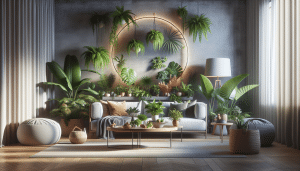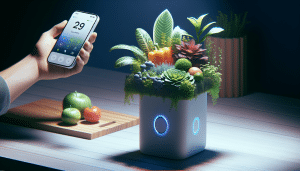You Can Transform Your Living Space with Indoor Plants
Henry King October 16, 2025
Bringing nature indoors has never been more rewarding. Explore the world of indoor plants, learn proven care tips, uncover health benefits, and discover how the right greenery can dramatically enhance your living space. This guide dives into everything you need to know to successfully grow and nurture houseplants at home.
Why Indoor Plants Matter for Your Well-Being
People are increasingly drawn to indoor plants, not just for visual appeal but for their positive effects on well-being. Studies indicate that adding greenery to a home environment can boost mood and support a healthier indoor atmosphere (Source: https://www.ncbi.nlm.nih.gov/pmc/articles/PMC4419447/). Certain houseplant varieties help purify indoor air, absorbing pollutants and increasing humidity, which can be especially beneficial for those spending much time indoors.
Plants like pothos, snake plant, and peace lily have gained popularity for their ability to thrive with minimal care while still making a big difference in home comfort. Many individuals find that even small touches of nature help reduce stress and boost feelings of relaxation and focus. Creating ‘green corners’ or mini plant groupings can transform any room into a soothing retreat.
Research links indoor gardening with enhanced productivity and cognitive function. Whether you work from home or simply want a more inviting living area, integrating houseplants is an enjoyable way to enrich daily life. They support indoor air quality and provide subtle but vital connections to the calming effects of the outdoors—without ever stepping outside.
Choosing the Right Indoor Plants for Your Space
Selecting plants suited to your environment is key for success. Different varieties have unique light, water, and humidity needs, so matching them with your living space increases the odds of thriving greenery. For beginners, look for resilient options like spider plant, zz plant, or dracaena—these tolerate occasional neglect and variances in lighting (Source: https://extension.umn.edu/houseplants).
Measuring the light levels in a room helps determine which species might suit your home. East-facing windows offer gentle morning sun, ideal for most houseplants. North-facing spaces work better for ferns or low-light lovers, while south-facing windows provide brightness for succulents and cacti. Evaluating humidity helps too; bathrooms and kitchens often accommodate moisture-loving varieties.
Size also matters. Tall plants like fiddle leaf fig or rubber tree make striking statements in corners, while vines and small potted varieties fit on shelves or desks. Mixing sizes and textures introduces interest and mimics natural diversity. Always research before buying—a simple step that helps your green investments flourish, regardless of your gardening experience.
Simple Indoor Plant Care Tips Everyone Can Use
Consistency is essential when it comes to indoor plant care. While each species needs individual attention, general rules make nurturing your plant collection much easier. Water thoroughly only when soil dries for most varieties. Overwatering is a common concern—roots need to breathe, so allowing soil to dry between waterings prevents issues like root rot (Source: https://www.rhs.org.uk/plants/popular/houseplants/care).
Light matters just as much as water. Rotate potted plants regularly so each side receives equal sunlight, which encourages even growth and prevents leaning. If windows are limited, grow lights can supplement natural light indoors, making almost any room suitable for plants. Pay attention to leaves—yellowing or browning often signals improper watering or lighting, rather than disease.
Dust can quickly accumulate on broad leaves, reducing their ability to photosynthesize. Occasionally wipe leaves with a damp cloth, and inspect for signs of pests like spider mites. A balanced, slow-release fertilizer supports healthy foliage, especially during the active spring and summer growing months. Caring doesn’t have to be complicated—routine habits build a healthy, lush indoor garden.
Popular Indoor Plant Varieties and Their Unique Benefits
Certain indoor plants offer unique advantages beyond beauty. Snake plants and pothos, for example, are admired for surviving in low light and filtering common pollutants such as formaldehyde. Peace lilies are equally valued, improving air quality and producing elegant white blooms year-round (Source: https://www.epa.gov/indoor-air-quality-iaq/indoor-plants-and-air-quality).
Succulents and cacti are go-to choices for those seeking low-maintenance décor. Their ability to store water means they require less frequent watering, which fits busy lifestyles. For those wanting visual drama, the fiddle leaf fig or monstera deliciosa provides bold foliage and becomes a focal point. Small-space dwellers can opt for trailing ivy or pilea, which grow well in compact areas.
Families with pets might look for non-toxic plant options such as spider plants or parlor palms. Beyond aesthetics, many varieties help boost indoor humidity, potentially easing dry skin and respiratory irritation, particularly in winter. Selecting a mix of plants tailored for different rooms can deliver both functional and decorative benefits, making plant care a rewarding home ritual.
Designing Your Space with Houseplants
Integrating houseplants into interior design is an enjoyable creative process. Plants can soften hard edges, bring color to neutral palettes, and define distinct living zones within open spaces. Consider placing tall species near windows and clustering small pots on side tables, shelves, or even hanging them for a lush, vertical effect (Source: https://www.houzz.com/magazine/how-to-decorate-with-houseplants-stsetivw-vs~91515639).
Experiment with containers—from modern ceramics to handwoven baskets—to complement your décor style. Grouping plants with different leaf shapes and colors creates a dynamic mini-jungle look and draws the eye. For minimalist spaces, a single statement plant may offer the perfect touch of green without visual clutter. The versatility of houseplants means there’s a fit for every taste.
If shelf space is limited, wall-mounted or hanging planters offer creative solutions. Bathrooms often prove ideal for ferns or orchids that love steamy atmospheres, while kitchen counters suit culinary herbs such as basil or mint. The key is blending utility with style—well-placed greenery naturally makes any home feel more harmonious and alive.
Common Indoor Plant Challenges and How to Overcome Them
No plant parent’s journey is perfect—challenges are part of the process. Most problems, like wilting or yellow leaves, boil down to inconsistent watering or inadequate light. Regularly checking the soil moisture and rotating pots to ensure even sun exposure helps address these issues and keep plants healthy (Source: https://www.gardeners.com/how-to/houseplant-care/7981.html).
Pest infestations—such as spider mites or fungus gnats—may crop up occasionally, especially in dense plant groupings. Swiftly isolating affected plants and using natural remedies like neem oil or gentle soap solutions can control outbreaks without harming others. Regular inspections are key for prevention. Understanding the watering needs of each species reduces the risk of root problems and fungus.
Even seasoned enthusiasts face setbacks. Learning from a dying plant—by researching what went wrong—paves the way for better outcomes next time. Most indoor plant issues can be traced and solved with observation and patience. Adaptation is part of the joy, and each small success builds confidence for more ambitious indoor gardens down the line.
References
1. Bringslimark, T., Patil, G. G., & Hartig, T. (2009). The psychological benefits of indoor plants: A critical review of the experimental literature. Retrieved from https://www.ncbi.nlm.nih.gov/pmc/articles/PMC4419447/
2. University of Minnesota Extension. (n.d.). Growing houseplants successfully. Retrieved from https://extension.umn.edu/houseplants
3. Royal Horticultural Society. (n.d.). Houseplant care. Retrieved from https://www.rhs.org.uk/plants/popular/houseplants/care
4. U.S. Environmental Protection Agency. (n.d.). Indoor plants and air quality. Retrieved from https://www.epa.gov/indoor-air-quality-iaq/indoor-plants-and-air-quality
5. Houzz Editorial Staff. (n.d.). How to decorate with houseplants. Retrieved from https://www.houzz.com/magazine/how-to-decorate-with-houseplants-stsetivw-vs~91515639
6. Penn State Extension. (n.d.). Indoor plant care. Retrieved from https://extension.psu.edu/indoor-plant-care







